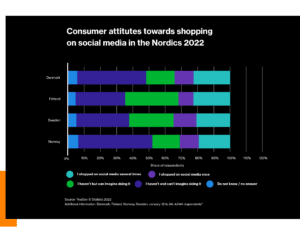How to Ride the Surging Wave of Social Commerce
Discover how to ride the surging wave of social commerce without getting drowned by its massive potential and choose the right channels for your business.
Ecommerce experienced 10 years worth of growth during the first three months of the pandemic, according to research by management and consulting firm McKinsey.

With the rising global influence of social media, it was only a matter of time before it moved on from selling sponsored ads to tapping into the vast and lucrative world of online retail. Through the seamless incorporation of direct purchase on social media platforms, social commerce was born. Coupled with the explosion of TikTok into the viral scene and the physical restrictions caused by the pandemic, leading to a heightened dependency on social media for community interactions, the sharp ascent of social commerce is inevitable, and we’re here to guide you on how to ride the surging wave of social commerce effectively with a suitable strategy, platform, and branding, that can convert the consumption of content into a product purchase.
What is Social Commerce?
Social Commerce is defined as the social media activity that takes place where the transaction happens in a social media app or in a social media platform. Social media activity leading up to the moment of transaction, or social media activity that takes place without in-app or in platform transaction is defined as social media marketing
As an extension of social media marketing, social commerce allows consumers to make in-app purchases through the ads they see on the platform, rather than having to take extra steps in clicking on a link to the brand’s external e-commerce site for purchase to be done. With social commerce, browsing through your feed on social network sites now comes with another social activity – shopping.
Taking full advantage of the reach and engagement of social media, social commerce assimilates the buying action within the habitual browsing process of consumers, accomplishing a seamless transaction on social media. You could be casually scrolling through Facebook or Instagram for updates from your friends, family, or favourite influencers and come across a sponsored post featuring the watch you had previously clicked to like. The image appears to have a “View Product” tag, which brings you to a product page, still within the app, with pricing and details on the watch. You then select your favourite color and click on “Place Order” with the payment details that were already saved on the app. Upon completion of the purchase, you are back on your feed to continue browsing for updates. That is the subtle influence of social commerce, which is currently on the rise.

In 2022, Facebook and Instagram clearly dominate social shopping in the Nordic countries.
Danish consumers were the most eager to shop on social media in the Nordic countries, according to a Statista survey from January 2022. Almost one in four consumers from Denmark had already shopped on social media platforms several times, while 23 percent of Finish respondents did the same.

With the wave of opportunities that come with social commerce, it’s a phenomenon that’s impossible for businesses to ignore, but with the expansive range of social media platforms available, businesses have to be careful in their selection of platforms that best align with their business needs, or risk getting drowned in the relentless wave of viral content in the age of social media.
3 Main Types of Social Commerce
Although Facebook and Instagram are the incumbents in the social commerce space, other platforms as Pinterest, Snapchat and TikTok are showing great innovation.
Especially TikTok has taken the world by storm since its introduction to the social media scene in 2017, which is an indication that the growth of social media channels is far from over. With the wide range of social media platforms available, each offering different functions and attracting different audiences, we classify them into types of social commerce platforms you can tap on, according to your business objectives.
For Social Influence – Facebook and Instagram
As the platform that kickstarted the modern era of social networking in 2006, Facebook is currently the largest social media platform in the world with 2.85 billion monthly active users worldwide, while Instagram is raking in 1 billion monthly active users globally. Having the furthest reach among all social media platforms, Facebook and Instagram, with their ability to share photos, stories, and videos, continue to command the most social influence through their channels.
Under the same parent company, Meta, Facebook and Instagram may have different target audiences, but they share similar functionalities, whether through the linking of Instagram Shopping to a Facebook business profile or the sharing of Instagram stories via Facebook and vice versa. On Instagram Shopping and Facebook Shops, once a product catalog is uploaded and product tags are added to each item, users can purchase directly through shoppable posts, where a click on the tags in the posts will bring them to the product details page within the app to purchase. In addition, with sophisticated algorithms capturing data on user preferences, both platforms enable users to discover products they have previously shown a preference for, thereby increasing their likelihood to purchase. Both Facebook and Instagram also have a messaging function that allows customers to communicate for support when necessary.
For Inspiration – Pinterest
When it comes to Pinterest, it is the product that takes center stage. Launched as a platform for users to create inspirational mood boards, the platform becomes commercially viable by offering shoppable product pins for users to access the specific product details to purchase the products that can help them build the lifestyle they aspire towards. However, Pinterest’s pins redirect users to the product page on the brand’s website, rather than allowing the purchase to be completed within the app.

For Viewing Pleasure – TikTok
TikTok may be the newer kid to the block, as compared to other video-sharing sites such as Youtube, Snapchat, and Twitch, it has developed a more intricate social commerce platform with shoppable posts and live-streaming capabilities, fully tapping on its highly impactful influencer marketing and viral content. While video ads with a “Shop Now” button that brings users to the brand’s external e-commerce site for purchase are prevalent on the feed, businesses are also able to construct a shopfront on TikTok under the new Shopping tab, allowing in-app purchases to be made. With the highly viral content on TikTok, each shoppable post may gain a larger viewership and engagement than other social media platforms.

Riding the Wave of Social Commerce
To effectively ride on the wave of social commerce, businesses need to first identify their business objectives, target audience, and goals, before deciding on the suitable platforms and channels to reach their specific audience with a higher likelihood conversion.
While conversion is an immediate, short-term goal that most businesses would like to reach, the effect of long-term demand through establishing a strong brand awareness should not be neglected as well. This is especially so for high-end luxury products and services, where the conversion is highly dependent on customised service, exclusive experience, and a high level of trust and credibility.
Achieving both conversion and demand requires a strong social commerce strategy, where the brand messaging is strong and the call-to-action is clear. There is also a need for a seamless social commerce experience for consumers to make their purchases as smoothly and naturally as they are browsing through their feed. Such strategy may be dependent on a large number of factors as well, ranging from the accessibility of the go-to-market, the development of payment infrastructure on social media platforms, and the quality of influencers in driving the right brand message.
Ultimately, the strategy needs to be grounded and refined by customer insights derived from the data gathered from past campaigns. With the customers at the center, these insights provide a deeper understanding of their preferences and purchasing behaviours, which may also lead to a discovery of new audiences, as well as retargeting of existing customers. By tracking results and optimizing existing strategies, businesses will be able to build and measure successful campaigns to expand their reach over time.
What’s Next for Social Commerce
With the enormous potential in social commerce, there are numerous benefits that come with its wider reach, deeper engagement, generation of social proof, and convenience to purchase, as compared to traditional e-commerce sites. These include a higher conversion rate, heightened brand awareness as well as enhanced brand loyalty.
While there’s no stopping the wave of social commerce, traditional e-commerce platforms are starting to take heed and acknowledge the impact of social influence when it comes to sales conversion. This has led to the development of live-streaming functionalities on e-commerce platforms like Shopee and Lazada to fill the gap in social interaction and engagement, in order to drive sales. As the shoppable options for consumers increase, brands need to be shrewder in choosing the suitable platforms to not just reach, but also engage and eventually convert their target audience to paying customers.
Keen to learn more about the effective strategies to build social commerce for your business? Contact us at [email protected].
FAQ:
1. Should I tap on all social media platforms to maximise my reach in social commerce?
Unfortunately, one size doesn’t fit all when it comes to social commerce. It is essential to consider your business objectives and choose the right social media platform(s) to reach your target audience. Also, with the vast number of platforms out there, you will have to look into the resources you have to ensure consistent updates on them. Therefore, it’s better to keep to specific platforms you can build an audience on, rather than spreading your resources thin on a wide range of platforms with minimal results.
2. What makes a good social commerce strategy?
A successful social commerce strategy drives both long-term and short-term benefits to businesses in future demand and conversion, respectively. To achieve that, it requires a strong, effective branding message and mechanisms that can fulfill customer needs, as well as the ability to harness the data for a better understanding of customer behaviours to further improve the existing strategy. Good thing that Wavemaker has all the services you need to create a winning social commerce strategy that aligns with your business needs.
3. How is social commerce different from e-commerce?
Social commerce is effectively e-commerce on social media platforms or channels. While e-commerce is largely centered upon the products on the brand’s website or an online marketplace like Amazon, social commerce takes place outside these sites, on the social media platforms that allow direct purchase. This shifts the influence to purchase from being product- and price-centric to being based on community interaction and shared content. Although e-commerce relies on digital marketing to bring visitors to the sites, social commerce seamlessly integrates into the social media platforms that users are browsing on, allowing them to buy what they see directly, without even having to leave the platform to make the purchase. Interestingly, the tide may be changing for traditional e-commerce platforms as they try to integrate social features, such as live streaming, on their platform, recognizing the influence of social interaction in driving sales.










